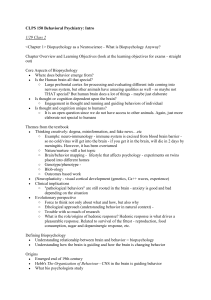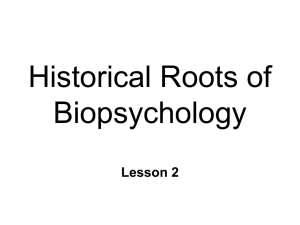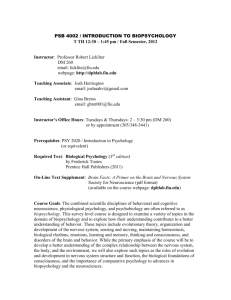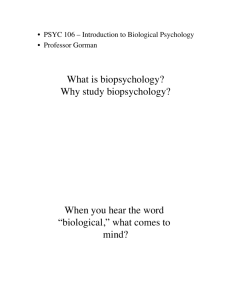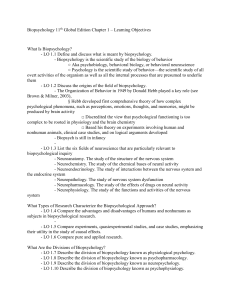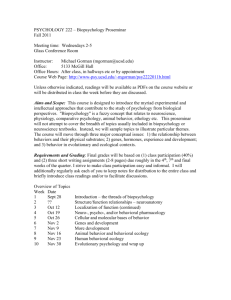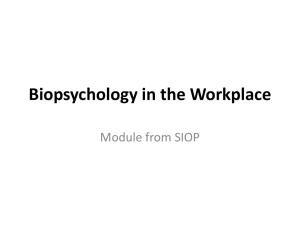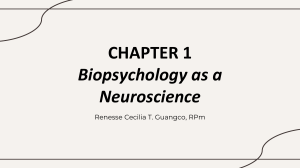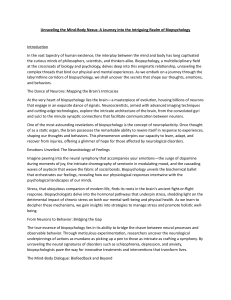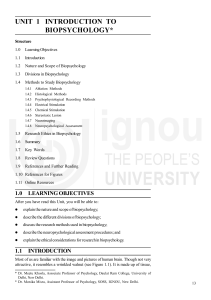CLPS 150 Notes
advertisement
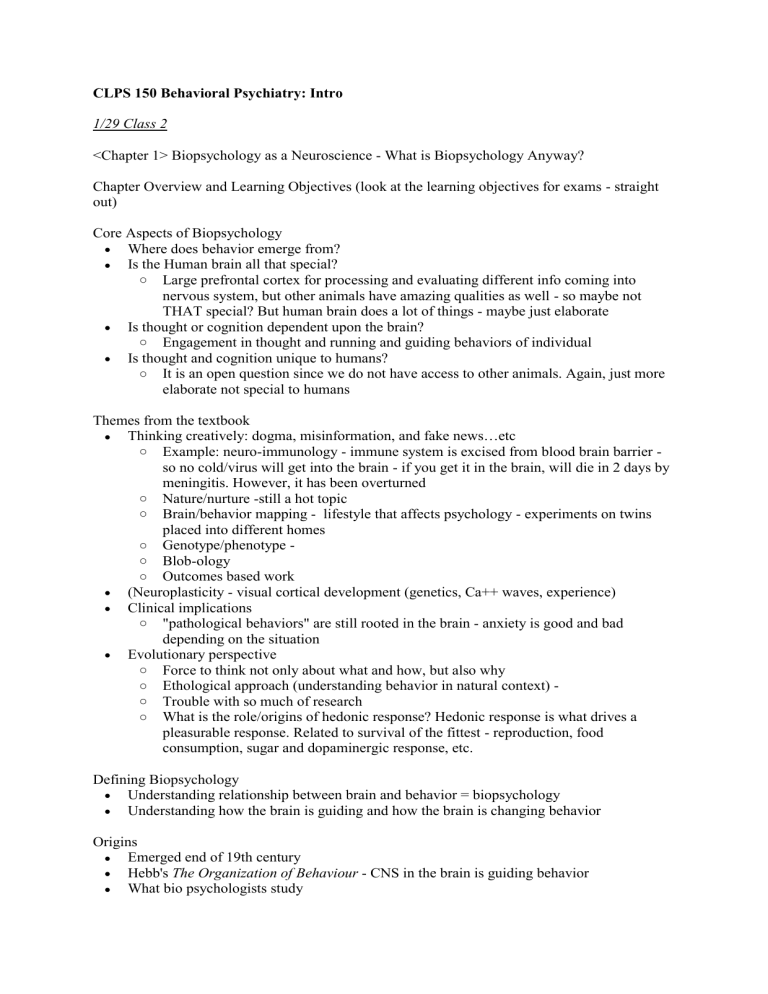
CLPS 150 Behavioral Psychiatry: Intro 1/29 Class 2 <Chapter 1> Biopsychology as a Neuroscience - What is Biopsychology Anyway? Chapter Overview and Learning Objectives (look at the learning objectives for exams - straight out) Core Aspects of Biopsychology Where does behavior emerge from? Is the Human brain all that special? o Large prefrontal cortex for processing and evaluating different info coming into nervous system, but other animals have amazing qualities as well - so maybe not THAT special? But human brain does a lot of things - maybe just elaborate Is thought or cognition dependent upon the brain? o Engagement in thought and running and guiding behaviors of individual Is thought and cognition unique to humans? o It is an open question since we do not have access to other animals. Again, just more elaborate not special to humans Themes from the textbook Thinking creatively: dogma, misinformation, and fake news…etc o Example: neuro-immunology - immune system is excised from blood brain barrier so no cold/virus will get into the brain - if you get it in the brain, will die in 2 days by meningitis. However, it has been overturned o Nature/nurture -still a hot topic o Brain/behavior mapping - lifestyle that affects psychology - experiments on twins placed into different homes o Genotype/phenotype o Blob-ology o Outcomes based work (Neuroplasticity - visual cortical development (genetics, Ca++ waves, experience) Clinical implications o "pathological behaviors" are still rooted in the brain - anxiety is good and bad depending on the situation Evolutionary perspective o Force to think not only about what and how, but also why o Ethological approach (understanding behavior in natural context) o Trouble with so much of research o What is the role/origins of hedonic response? Hedonic response is what drives a pleasurable response. Related to survival of the fittest - reproduction, food consumption, sugar and dopaminergic response, etc. Defining Biopsychology Understanding relationship between brain and behavior = biopsychology Understanding how the brain is guiding and how the brain is changing behavior Origins Emerged end of 19th century Hebb's The Organization of Behaviour - CNS in the brain is guiding behavior What bio psychologists study o How the brain and the rest of the nervous system determine what we perceive, feel, think, say, and do o Can we predict all the behaviors by studying the brain? The ultimate challenge o Does our brain have the capacity to understand something as complex as itself? What differentiates a Neuroscientist from a Bio psychologist? Intersection between the two Biopsychology is related to what disciplines of neuroscience? o 6: neuroanatomy, neurochemistry, neurophysiology, neuroendocrinology, neuropharmacology, neuropathology Neuroanatomy: Cajal - identified different cells in the brain o Describing of the nervous system - important in understanding Karl Lashley and the Engram o 1950s Engram – neuro extension of memory o Still labs trying to figure out: Xu Liu and Steve Ramirez - a mouse laser beam manipulated memory - they can reactivate the fear memory and expressing the memory o Activating the mood state Neurophysiology: Started Barlow 1953 mapping retinotopic maps, visual streams, etc (EEG recordings) retinotopic map is represented in mirror image from the visual image The techniques still being used at Brown - BrainGate Neuropharmacology: Religious tradition - Andes Freud - 1884 "On Coca" - use of cocaine in religious tribes, psychoactive component of the plant How different drugs have an impact on behavior - can help with depression, migraine, etc. SSRIs - usually identified by accident and modifying, we are not discovering new drugs Example: Ketamine - used for anesthetic with paralytic for certain procedures, does have psychoactive components. Helps depression (Lisa Monteggia study on animals and depressive properties) - moved into clinical trials Neuropathology: Phineas Gage - missing prefrontal cortex after the rod went into the brain, but massive change in behavior - different person CTE - Bennet Omalu, many football and boxing players have changes Neurochemistry: Acetylcholine - first neurotransmitter by Henry Dale then Otto Loewi - contraction of the heart, also signaling between cells for cognition and behavior Continuation: Oxytocin - the love molecule, important for pair bonding or prosocial and mating behavior o 1910-20s - it was for reproductive physiology when first discovered - to induce labor in uterus and feeding babies Neuroendocrinology: Stress, puberty- How stress changes behavior Misattribution of arousal - regulating the perception of things (social psych) - perception of the world is dependent upon physio state (state of the body) o Took series of images of attractiveness, also on suspension bridges. Feel stronger feelings of level of attractiveness by physiological arousal Approaches to studying biopsychology Human vs non-human subjects o Pluses and minuses? Humans are easier, animals need to be more effort to understand Non-human subjects are faster to look at birth to death - developmental studies, also access to different body tissues What is the premise for this comparison? o Studying basic behaviors - but might be invalid in some Animal research and IACUC? o How is animal research regulated? Highly regulated by different gov committees. Has to be submitted by vets, scientists, etc. usually more regulated than humans (IRB board) Humans and Nonhuman subjects (BOOKs rationale) - some are good and some are bad Advantages of humans (e.g. Milgram's studies) o Follow directions o Report subjective experience o Less expensive o Human brain Advantages of nonhuman subjects o Simpler nervous systems o Comparative approach o Fewer ethical constraints Experimental Approach Experiments o Used for cause and effect relationships o between and within subjects’ design o Independent variables (things you manipulate) o Dependent variables (thing you measure) o Confounding variables (possible contributing factors) Sleep study example Population, Group assignment, manipulation, testing conditions, confounding variables? Random assignment Quasiexperimets Used when controlled experiments are impossible - developmental studies in orphanages, placed half in foster care Self-selected subjects (not always) Key problem-can't control confounds 1/31 No Class (Cancelled) 2/5 Pure and applied research Pure research o Curiosity of the researcher o Focus on basic concepts o Core principles of science o Issues (ethical, justification, etc) benefits? o Example? Applied research o Use basic research to answer specific problems – immediate impact, tangible present problems o Examples – individuals suffering a disorder o Not necessarily applied to humans, etc. can be for basic science Six divisions of biopsychology Physiological psychology o Direct manipulation of nervous system o Mostly lab animals (most study done in animal models) o Focus on pure research o (Ephys, Opto, Wilder Penfield) o You can drive change in behavior, state of animals, based on how you stimulate certain regions of the brain Psychopharmacology o Manipulation of nervous system pharmacologically o Focuses on drug effects on behavior o Drug effects change neural activity o Conduct both pure and applied questions o New approaches – DREADDs Insert a designer receptor Insert a drug that responds specifically to the receptor o Describe a psychopharm experiment Ketamine – how it affects suicidality IV: ketamine, DV: suicidality Neuropsychology o Focuses on behavioral effects of brain damage o Uses case studies and quasi-experimental designs o Applied research o What kind of subject? o What kind of experiment can be done? Psychophysiology o Focuses on physiological and psychological processes o Uses non-invasive recordings from humans (physical responses) Muscle tension Eye movement Pupil dilation Electrical conductance of the skin o Stress and perception o EEG and attention o Visual tracking Tacking of a pendulum by a normal control participant and people with schizophrenia Cognitive neuroscience o Newest division o Focus: neural basis of cognitive processes (test which regions of the brain are most active) Learning/ memory Attention Perceptual processes o Use noninvasive, functional brain imaging (can use human subjects, not limited to animals) o Often collaborative between varied scientists o Restricted to humans? o Benefits and limitations? o Functional brain imaging – control scan (reveal high levels of neural activity at one level of the brain) Comparative psychology o Focus on biology of behavior o Features comparative and functional approaches Example of comparative approach – genetic risk for depression and treatments – identify particular mutations of genes, which was rich in certain individuals with depression o Features laboratory and ethological studies Whether mutation change in animals brings changes B, d, and f gene o Includes evolutionary psychology and behavioral genetics Development of clinical trials in humans Converging operations: how do bio psychologists work together? Each area has a weakness Must collaborate to ask good questions Converging operations o Progress made using different approaches o Each compensates for the shortcomings of others Chapter 2 Idea of dichotomous to … Nature vs nurture Fundamental of genetics Epigenetics (development of organism) The origins of dichotomous thinking Is it physiological or psychological? o Product of sensory experience or more? Is it inherited or is it learned? (nature vs nurture) o Product of gene, environment, or both? o Watson (nurture) vs Ethology (nature – instinctive behaviors) o May combine, not always one or the other
